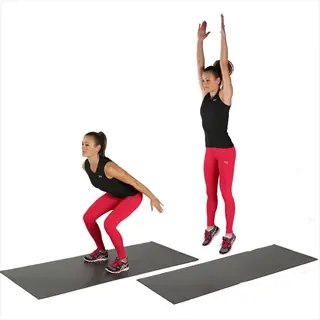10 Key Benefits of High Intensity Interval Training

Written by
David Nelson
Reviewed by
Prof. William Dalton, Ph.D.High intensity interval training burns more calories in less time than traditional cardio.
Targets dangerous visceral fat 17% better than steady-state workouts for abdominal reduction.
Boosts cardiovascular health by improving VO₂ max 8-12% within just six weeks.
Enhances metabolic efficiency through significantly increased insulin sensitivity in diabetics.
Triggers powerful endorphin release that improves mood and reduces pain perception.
Requires zero equipment and adapts to any environment for universal accessibility.
Article Navigation
High-intensity interval training consists of alternating brief, maximum-effort bursts with periods of recovery. Work hard during the bursts (20-60 seconds) and then recover. It is possible to burn more calories in a 20-minute workout than in a 40-minute workout using traditional methods. HIIT will also maintain the metabolism for hours after the workout. Anyone can start doing HIIT, regardless of their fitness level.
Those new to the sport often fret about intensity. It is recommended to begin with modified versions of the routine, using a longer recovery period and increasing speed. The emphasis should be placed on proper form rather than speed, as the body adapts rather quickly. In a matter of a few weeks, one may easily note improved stamina. This method is suitable for all ages and physiques.
Equipment-Free Routines
Beginner workouts do 20 seconds of work followed by 40 seconds of rest. Begin with lower-impact moves, such as modified squats and step-back lunges, which provide endurance benefits while reducing joint stress. Burn about 8-10 calories per minute relatively safely. Appropriate form should be increased before intensity is increased. This not only provides a foundation for more advanced exercisers, but also helps prevent injury.
For intermediate training, use a 30-second work period and a 30-second rest period. Incorporate jumps, such as squat taps, in a controlled manner. The breathing should be heavy but controlled; this increases calorie burning to 12-14 calories per minute. For high-impact exercises, step instead of jumping. This is an effective measure for protecting the knee and ankle joints.
Experienced routines require a maximum of 45 seconds of effort with 15 seconds of rest. Include explosive burpees and mountain climbers. You create an EPOC effect, burning extra calories hours after the workout. Expect to burn 15 or more calories per minute during workouts. Always land softly to cushion joints. Your metabolism stays elevated.

Beginner: Jumping Jacks
- Start with feet together and arms at sides, then jump while spreading legs shoulder-width apart and raising arms overhead in a continuous motion
- Maintain soft knee landings throughout all repetitions to reduce joint impact during the movement sequence for joint safety
- Complete 30 seconds of continuous maximum-effort repetitions followed by 30 seconds of complete rest or gentle marching recovery
- Repeat this work-rest cycle six times for a total active workout duration of three minutes with progressive intensity
- Focus on controlled breathing patterns during exertion phases to maintain optimal oxygen flow to working muscles throughout
- This foundational routine elevates heart rate safely while improving coordination and basic cardiovascular endurance capacity effectively
- Surprising twist: Perform near a wall for balance support if needed, allowing higher jump frequency without stability concerns

Intermediate: Burpees
- Begin standing upright, drop into squat position with hands firmly planted on floor, then kick feet back explosively to plank position
- Perform a controlled push-up before returning feet to squat position and exploding upward into a vertical jump
- Execute 45 seconds of continuous repetitions at maximum sustainable pace while maintaining strict form throughout each phase
- Follow with 45 seconds of standing recovery incorporating deep breathing techniques and gentle shoulder mobility movements
- Complete five full cycles of this sequence for balanced cardiovascular and muscular endurance development benefits
- Modify by omitting the push-up or jump components for reduced impact while preserving metabolic intensity advantages
- Surprising twist: Use park benches for elevated hand placement to reduce wrist strain while increasing range of motion

Advanced: Squat Jumps
- Start in athletic stance with feet positioned wider than shoulder width apart, then lower into deep squat position
- Explode upward into maximum vertical jump reaching arms overhead before landing softly with bent knees in squat
- Sustain maximum effort for 60 seconds with minimal ground contact time between jumps to maintain intensity
- Recover for 30 seconds with light jogging in place or dynamic stretching movements to facilitate oxygen replenishment
- Perform eight complete cycles to challenge power development and anaerobic capacity through progressive overload
- Add external resistance through weighted vests once bodyweight adaptation occurs to continue strength progression
- Surprising twist: Incorporate stairs by landing on different steps to increase power development and mimic real-world terrain

Outdoor: Stair Sprints
- Find a staircase with at least 20 steps and ascend rapidly at maximum speed while pumping arms powerfully
- Focus on driving knees upward and pushing through toes to maximize power transfer with each step taken
- Sprint upward for 30 seconds of intense effort followed by 60 seconds of walking recovery back down
- Maintain upright posture with slight forward lean to optimize power transfer and minimize injury risks
- Complete eight repetitions to develop explosive leg power and cardiovascular endurance simultaneously outdoors
- Adjust intensity by taking two steps at once for increased challenge or single steps for beginners
- Surprising twist: Descend backward during recovery to engage different muscle groups and improve proprioception
Safety and Precautions
Heed the warnings of pain from your body before it turns to pain. If you experience severe pain in your joints or feel dizzy, stop frequently. Hydrating helps with the intensity of your workout. Drink 17 ounces of water two hours before high intensity intervals. Drink 7 to 10 ounces every 20 minutes during exercise. If exercising lasts over 30 minutes, replenish with electrolytes.
Poor form is your number one indicator that you need a rest day. If your knees buckle during jumps or your back arches during planks, then stop immediately from your workout. Trading proper form for speed is a surefire way of injuring yourself. Film yourself once a month to identify flaws in your movements. If you use the correct form, then you will have effective workouts without unnecessary exertion.
Recovery boosts performance instead of detracting from it. Allow 48 hours for muscle tissue repair from intense workouts. Monitor morning heart rate: increases over 10% indicate inadequate recovery. Use foam rolling and compression garments to minimize inflammation. Smart recovery makes your next workout stronger.
Progressive Intensity Approach
- Begin with just three maximum-effort intervals per session to allow physiological adaptation
- Increase to five intervals after two weeks once breathing control improves consistently
- Never exceed eight high-intensity intervals regardless of experience level to prevent overtraining
- Track perceived exertion daily using the 1-10 scale to identify sustainable intensity thresholds
Hydration Protocol
- Drink 17 oz (500ml) of water two hours before starting any high-intensity session
- Consume 7-10 oz (200-300ml) every 20 minutes during exercise in warm environments
- Replace electrolytes after sessions lasting over 30 minutes with sodium-rich options
- Monitor urine color as hydration indicator: pale yellow indicates optimal fluid balance
Form Preservation
- Prioritize movement quality over speed when fatigue compromises exercise technique
- Reduce range of motion before sacrificing proper joint alignment during repetitions
- Terminate interval immediately if back arches during planks or knees collapse inward during jumps
- Film sessions monthly to self-assess form degradation points needing correction
Recovery Monitoring
- Require 48 hours between high-intensity sessions for complete muscle tissue repair
- Measure morning resting heart rate: increases above 10% indicate insufficient recovery
- Incorporate foam rolling for myofascial release targeting quads, hamstrings, and calves
- Utilize compression garments post-session to reduce inflammation markers by up to 30%
Environmental Considerations
- Avoid outdoor sessions when temperatures exceed 90°F (32°C) due to heat stroke risks
- Maintain indoor ventilation rates of at least 20 cubic feet per minute per person
- Use non-slip surfaces for jumping movements on all flooring types to prevent falls
- Select cross-training shoes with lateral support specifically designed for multi-directional movements
Heart Rate Targeting
Use this simple calculation to find your maximum heart rate: 220, minus your age. This is your absolute maximum limit. Aim for 60-70% of this for fat burning during recuperation phases. Cardiovascular improvement needs 80-90%, during violent outbursts. Know your zones.
Coordinate perceived effort to actual heart rates. A level 4-5 effort feels like light jogging and gives a heart rate of 6070% maximum. An 8-9 effort feels breathless and hits the 8595% level. During rest periods, use the talk test to assess exercise intensity accurately.
Track your pulse without any gadgets. Immediately after the high-intensity intervals, press two fingers below the base of your thumb and count the beats for 30 seconds; then multiply by 2. You can use this manual method anywhere. Tracking consistently keeps you in the best zones.
Manual Pulse Measurement
- Locate radial artery on wrist with index and middle fingers below thumb base
- Count beats for 30 seconds immediately after high-intensity interval completion
- Multiply count by two to determine current heart rate in beats per minute
- Compare result to calculated maximum heart rate for intensity verification
Perceived Exertion Scale
- Use the 1-10 Borg Scale where 1 represents minimal effort and 10 equals maximum exertion
- Aim for level 8-9 during high-intensity intervals with breathless but controlled effort
- Maintain level 4-5 during recovery periods with conversational breathing capacity
- Correlate personal perception with actual heart rate data during initial sessions
Wearable Technology
- Select chest strap monitors for highest accuracy during explosive movements
- Use optical wrist sensors with tight fit during low-motion activities only
- Analyze heart rate variability data for recovery assessment between sessions
- Set zone alerts at 85% and 95% of maximum heart rate for interval timing
Workout Application
- Target 85-95% of maximum heart rate during high-intensity effort phases
- Maintain 50-60% during recovery periods before next intense interval
- Allow heart rate to drop by at least 20% before initiating next intense bout
- Track post-exercise oxygen consumption through elevated heart rate recovery
Post-Workout Analysis
- Record peak heart rate achieved during each high-intensity interval session
- Calculate average recovery time needed to return to 60% maximum heart rate
- Compare weekly trends to identify cardiovascular fitness improvements
- Adjust future workout intensity based on recovery pattern observations
Comparison With Steady-State Cardio
HIIT training may not burn as many calories during the workout. Still, it creates a significant effect in the days that follow. A 20-minute HIIT workout might burn off 200 calories while exercising and an additional 100 calories after the fact, resulting in an afterburn effect. Steady-state cardio might burn off 300 calories during a 40-minute jog, but hardly anything afterwards. Due to the EPOC effect, HIIT is better metabolically than SS cardio.
The joint impact varies dramatically with the different methods. For instance, HIIT's explosive jumps put tremendous stress on the knees and ankles. Cycling is a steady-state exercise that will have a low impact. HIIT should be done when the joints feel strong and resilient. During recovery periods or if the joints are already sore, steady-state cardio activities should be used.
These strategies differ significantly in terms of the time required to achieve the same health benefits. You can receive equal amounts of cardiovascular benefit from three 20-minute HIIT sessions/week compared to five 40-minute steady-state sessions per week. Compressed workouts fit better in the busy schedules of most people, and provide similar benefits in endurance improvement but half the time requirement per week.
Employ both techniques in a player's strategic manner. Utilize HIIT to boost your metabolism twice a week. Use steady-state training sessions for active recovery. This complimentary method maximizes benefits while minimizing injury potential. Your progressive fitness program becomes more sustainable and well-rounded.
When to Choose High Intensity Interval Training
- Limited time availability with only 20-30 minutes for exercise sessions
- Plateau-breaking needs for metabolic rate enhancement and fat loss
- Training for sports requiring explosive power like basketball or sprinting
- Sufficient recovery capacity between sessions for high-impact movements
When to Choose Steady-State Cardio
- Joint sensitivity or recovery from lower-body injuries requiring low impact
- Endurance building for long-distance running or cycling events
- Active recovery days between intense training sessions
- Mindfulness or meditation integration during physical activity
Hybrid Approach Benefits
- Combine 2 High Intensity Interval Training sessions with 1-2 steady-state sessions weekly
- Use steady-state for warm-ups before High Intensity Interval Training intervals
- Apply High Intensity Interval Training principles to traditional cardio (e.g., hill sprints during runs)
- Alternate focus weekly based on energy levels and recovery indicators
Metabolic Differences
- High Intensity Interval Training elevates excess post-exercise oxygen consumption significantly higher
- Steady-state cardio primarily burns fat during the exercise session itself
- Combining both methods creates complementary metabolic effects for body composition
- High Intensity Interval Training improves insulin sensitivity more dramatically than steady-state
Equipment Considerations
- High Intensity Interval Training requires minimal equipment beyond proper footwear
- Steady-state cardio often utilizes machines like treadmills or ellipticals
- Bodyweight High Intensity Interval Training can be performed anywhere without specialized gear
- Both methods adapt well to outdoor environments with natural terrain variations
10 Key Benefits
The intensity interval exercise burns up to 25-30% more calories than moderate exercise in the same amount of time. This places a greater metabolic demand on the body, requiring an additional 9-15% of energy expenditure after exercise sessions. This EPOC effect allows for calorie burning for up to 24 hours. Therefore, better fat loss can be achieved without the need for marathon exercise sessions.
Within a few weeks, cardiovascular improvement can be observed. An 8-12% increase in VO2 max can be expected in as few as 6 workouts. There will be a decrease in resting heart rate of 5-8 beats, indicating increased efficiency. Insulin sensitivity will be increased by 23-35% resulting in improved glucose regulation. These physiological adaptations make everyday activities easier.
The greatest advantage is time efficiency, as you achieve effects comparable to those derived from 40 minutes or more of continuous cardiovascular effort in just 20 minutes or less. Minimal equipment required means you train anywhere at any time, and this versatility makes high-intensity intervals available to all fitness levels conveniently.
Superior Calorie Burning
- Burns 25-30% more calories than moderate exercise in equivalent time
- Creates metabolic demand requiring 9-15% more energy expenditure post-workout
- EPOC effect elevates calorie burn for up to 24 hours after session completion
Visceral Fat Reduction
- Targets dangerous abdominal fat surrounding internal organs
- Reduces waist circumference by 2-4 cm within 8 weeks of consistent training
- Decreases visceral fat storage by 17% compared to steady-state cardio
Cardiovascular Enhancement
- Improves VO2 max by 8-12% within 6 weeks of regular sessions
- Strengthens heart muscle efficiency better than prolonged moderate exercise
- Lowers resting heart rate by 5-8 beats per minute with consistent practice
Metabolic Efficiency
- Increases insulin sensitivity by 23-35% in diabetic and pre-diabetic individuals
- Enhances glucose metabolism more effectively than continuous cardio training
- Boosts mitochondrial density for superior cellular energy production
Endorphin Release
- Triggers natural mood elevation through endogenous opioid release
- Reduces perceived pain during intense efforts by 15-20%
- Creates post-exercise euphoria lasting 1-2 hours after session completion
Time Efficiency
- Delivers comparable fitness gains in 20 minutes versus 40+ minutes of steady cardio
- Meets weekly exercise guidelines with just 75 minutes of total training time
- Fits seamlessly into lunch breaks or before work routines
Minimal Equipment Needs
- Requires only bodyweight for fundamental movement patterns
- Adapts to any environment: parks, living rooms, or hotel rooms
- Utilizes stairs, hills, or curbs for added resistance outdoors
Performance Versatility
- Simultaneously develops aerobic and anaerobic energy systems
- Enhances athletic power output for sports requiring explosive movements
- Improves recovery capacity between high-intensity efforts
Blood Pressure Regulation
- Lowers systolic pressure by 7-12 mmHg comparable to hypertension medication
- Reduces arterial stiffness more effectively than continuous endurance training
- Three weekly sessions provide equivalent benefits to daily moderate exercise
Adaptability Across Activities
- Applies to cycling, running, swimming, rowing, and functional movements
- Modifiable for all fitness levels through interval duration adjustments
- Integrates with strength training through circuit-style implementation
5 Common Myths
High Intensity Interval Training is only for athletes and advanced fitness enthusiasts
High Intensity Interval Training protocols are adaptable to all states of fitness by scaling the intervals whereby beginners can follow shorter work periods and longer recovery periods while obtaining the same relative intensity based on their capacity thus facilitating safe progressive training without requiring previous athletic experience.
Longer fitness durations always lead to better fitness results than shorter ones
@Scientific tests show that brief Higher Intensity Training sessions lead to more efficient physiological adaptations than longer moderate workouts where, for example, 20 minutes of Higher Intensity Interval Training provide as much cardiovascular stimulation as 40 minutes of steady state cardiovascular work, causing an overall greater metabolic response and mitochondrial biogenesis resulting in longer lasting fitness advances.
Maximum output in High Intensity Interval training entails a sacrifice of movement form
Correct movement technique is vital in order to prevent injury during high intensity efforts, and effective training programs emphasize maintaining proper joint relationships at the immediate moment during all repetitions while ranking intensity by modifying our range of motion or the given skills or movements being taught, rather than sacrificing our movement form at the expense of perceived gains in intensity.
High Intensity Interval Training cannot increase muscular dimensions like classical strength training
High Intensity Interval Training promotes considerable muscular growth in the beginners and intermediate trainees by reason of the eccentric load in explosive movements, and studies have shown an increase in the percentage of type II fibers engaged leading to measurable hypertrophy when resistance-protocols are used, while advanced athletes need supplemental strength training for their highest muscular growth.
High intensity interval training (HITT) scheduled once daily maximizes results and advancment
For maximum results, there should be a 48 hour period between workouts for muscle repair and to avoid overtraining. Continuous intense workouts show increased cortisol levels, decreased immune function, and less improvement in gains than recommended schedule of three workout sessions a week alternating with active rest days.
Conclusion
High-intensity interval training offers incredible productivity for today's busy schedules. Its time-compressed routines yield metabolic benefits that traditional forms of exercise cannot duplicate. The key benefits are far greater calories burned and cardio improvements. These lead to improved fitness results without complicated time commitments.
Approach HIIT as a flexible foundation for fitness rather than a comprehensive solution. Begin with two weekly sessions of modified exercises. At first, focus on consistent effort rather than maximum intensity. Your body safely adapts to an increased demand over time.
Emphasize implementing sustainably for results that last. Measure non-scale victories, such as improvements in energy levels and endurance. Pair with other activities to develop a more balanced fitness program. This gradual approach fosters lifelong habits more effectively than an extreme, unsustainable increase in physical activity levels.
External Sources
Frequently Asked Questions
What defines a high intensity interval workout?
High intensity interval training alternates maximum-effort bursts with recovery periods, creating metabolic demand. Key characteristics include:
- Short work intervals (20-60 seconds) at 85-100% maximum effort
- Active or complete rest periods matching or exceeding work duration
- Total session time under 30 minutes including warm-up/cool-down
- Focus on compound movements targeting multiple muscle groups simultaneously
How frequently should I do HIIT sessions?
Optimal frequency balances results with recovery needs:
- Beginners: 2 sessions weekly with 48+ hours between sessions
- Intermediate: 3 sessions weekly with alternating activity types
- Advanced: 4 sessions maximum with careful monitoring for overtraining
- Always include 1-2 active recovery days with low-impact activities
Can HIIT effectively replace traditional cardio?
HIIT offers comparable cardiovascular benefits in less time while triggering unique physiological responses:
- Superior calorie burn during and after exercise via EPOC effect
- Greater insulin sensitivity improvements than steady-state training
- Faster VO₂ max development in compressed timeframes
- Combines aerobic and anaerobic conditioning simultaneously
What are common HIIT mistakes to avoid?
Critical errors compromise results and increase injury risk:
- Sacrificing form for speed during explosive movements
- Inadequate warm-up preparation before maximum efforts
- Neglecting hydration and electrolyte balance needs
- Ignoring joint impact limitations on hard surfaces
- Skipping scheduled recovery days between sessions
How does HIIT specifically target belly fat?
HIIT uniquely combats visceral fat through physiological mechanisms:
- Elevates catecholamines that mobilize abdominal fat stores
- Creates substantial oxygen debt for extended post-workout calorie burn
- Improves insulin sensitivity to reduce abdominal fat storage
- Triggers mitochondrial adaptations enhancing fat oxidation efficiency
Can beginners safely start HIIT training?
Beginners can successfully implement modified HIIT protocols:
- Start with work-to-rest ratios favoring longer recovery periods
- Choose low-impact movements before progressing to jumps
- Maintain perceived exertion at level 7-8 rather than maximum
- Focus on movement quality over speed or repetition count
- Gradually decrease rest intervals over several weeks
What equipment is essential for HIIT?
Effective HIIT requires minimal equipment:
- Proper athletic shoes with lateral stability features
- Non-slip surface for safety during explosive movements
- Interval timer application or basic stopwatch
- Optional: Yoga mat for floor-based exercises
- Optional: Heart rate monitor for intensity verification
How does HIIT impact cardiovascular health?
HIIT strengthens cardiovascular function through specific adaptations:
- Improves heart muscle contractility and stroke volume
- Enhances oxygen utilization efficiency in working muscles
- Reduces resting blood pressure through arterial flexibility
- Increases capillary density around trained muscle fibers
- Boosts parasympathetic nervous system recovery capacity
What recovery practices support HIIT training?
Essential recovery strategies maximize HIIT benefits:
- Hydrate with electrolyte-balanced fluids immediately post-session
- Utilize foam rolling for myofascial tension release
- Prioritize sleep quality for hormonal balance restoration
- Incorporate contrast showers for circulatory stimulation
- Consume protein within 45 minutes to support muscle repair
How long until visible HIIT results appear?
Noticeable physical improvements typically emerge progressively:
- Energy and endurance gains: 1-2 weeks
- Clothing fit improvements: 3-4 weeks
- Muscle definition changes: 5-6 weeks
- Significant body composition shifts: 8+ weeks
- Performance metric improvements continue beyond 12 weeks

